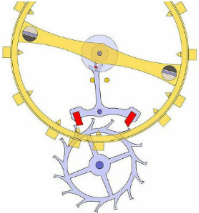Ron Gordon shares insights into what’s inside your watch, starting with the type of escapement.
As a premier Swiss Watch Repair shop in New York, NY, I love to share my knowledge about Swiss watches with my customers. Indeed, many customers buy luxury Swiss watches such as Tag Heuer, Rolex, Omega, Longines, Tissot, Rado, Hamilton, Baume & Mericer, and LeCoultre because of their quality craftsmanship. But few know how to look ‘inside’ their watches, and still fewer can appreciate the mechanical beauty of these fine timepieces. In this blog post, I would like to share some insights into the ‘escapement’ of these watches. An escapement, of course, is the device in mechanical watches that transfers energy to the timekeeping element (the “impulse action”) and allows the number of its oscillations to be counted (the “locking action”).

As is so often true in any industry, there are different solutions to this design challenge. All the watch companies Tag Heuer, Rolex, Omega, Longines, Tissot, Rado, Hamilton, Baume & Mericer, and LeCoultre use the Swiss lever escapement. The Swiss lever escapement comprises an escape wheel having teeth, and a lever having on the one hand an entry pallet and an exit pallet that engage alternately with the teeth of the escape wheel, and on the other hand a fork that engages periodically with an impulse pin on a roller mounted on the staff of a regulator balance wheel. The Swiss lever design appeared between 1850 and 1870. Nowadays, it is the most common escapement. It has been used in Swiss, American, and Japanese watches. The Swiss lever escapement is now more popular than the English lever escapement because the Swiss lever escapement causes less wear out of the escape wheel and has higher accuracy. You can click on the link below to see how it works –
Omega Watches and the Co-Axial Escapement
English master watchmaker George Daniels, who invented the Co-Axial escapement in the 1970s and worked closely with OMEGA on its industrialization, is justifiably proud of his creation. He says, “When it becomes more widely known to consumers that watches with Co-Axial escapements have better chronometric performance than their counterparts with classic lever escapements and that the Co-Axial watches have longer service intervals, the demand for Co-Axial calibres will accelerate dramatically. But it has another major role: it will extend the popularity of mechanical watches into the 21st century and beyond.” You can click on the 2 links below to see how it works.
- http://www.omegawatches.com/spirit/watchmaking/co-axial/how-it-works
- http://www.clockwatch.de/index.html?html/tec/hem/dan.htm
The first link also has a very slick video about the OMEGA Co-Axial. I repair OMEGA watches, of course, but as with any design change there are pro’s and con’s. Here’s their statement –
The main benefit of this new design becomes clear when it is compared with the lever escapement. The impulse in a lever escapement involves the wheel tooth sliding along the inclined surface of the pallet. This sliding movement generates considerable friction, making optimal lubrication vital if the escapement is to function correctly. However, lubricants are highly sensitive to ageing, as well as changes in their environment (temperature, humidity etc.) and therefore compromise the stability of the watch’s rate over time.
In contrast, the Co-Axial Escapement transmits energy using tangential forces provided by the components’ radial movements. Its very short sliding movement considerably reduces the contact surfaces and, therefore, the friction in the escapement. As a result, the escapement function is similar to that of a gear wheel meshing with a tooth, which means that it is unaffected by lubrication (a mere protective film on the tip of the escapement wheel teeth is sufficient to preclude wear and tear) and thus ensures a stable rate over the long term.
Now, again, there are pro’s and con’s to both types. If you are really interested in Swiss watches, stop by my shop or email me a comment on the blog. These watches are not just about style; they are microcosms of engineering, and in this case, there are competing solutions to certain design challenges.
About Ron Gordon Watch Repair
Ron Gordon Watch Repair is located at 280 Madison Ave, Ste. 510, New York, NY 10016. We provide watch repair services throughout New York City, Manhattan, Midtown Manhattan, Downtown and the boroughs of New York, NY. Read our Google Places, Insider Pages, and City Search Reviews, online.